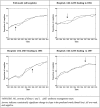The Belgian policy of funding antimicrobial stewardship in hospitals and trends of selected quality indicators for antimicrobial use, 1999-2010: a longitudinal study
- PMID: 25681314
- PMCID: PMC4330329
- DOI: 10.1136/bmjopen-2014-006916
The Belgian policy of funding antimicrobial stewardship in hospitals and trends of selected quality indicators for antimicrobial use, 1999-2010: a longitudinal study
Abstract
Objectives: In order to improve antimicrobial (AM) use, a policy of providing technical and financial support to AM management teams (AMTs) was rolled out in all Belgian hospitals between 2002 and 2008. We aimed to analyse the association of this policy with AM use for the two indications accounting for the largest number of patients receiving AM: prophylaxis for major lower limb orthopaedic surgery and pneumonia.
Design, setting, participants: We used patient-level data routinely collected in all Belgian acute care hospitals between 1999 and 2010. We modelled trends for selected quality indicators (QIs) using the year of AMT implementation in each hospital as the main 'change point', with fine-tuned case-mix adjustment. Of all admissions for lower limb orthopaedic surgery, and pneumonia between 1999 and 2010, 90% (325 094) and 95% (327 635), respectively, were found eligible for analyses.
Outcomes: The surgery QI was defined as: cefazolin, dose in the expected range, and no use of other AM. For pneumonia, QIs were: ratio of oral/parenteral defined daily doses (DDD, O/P QI), and mean number of DDD minus penicillin, per 100 days of hospitalisation (DDD QI).
Results: Between 1999 and 2010, the surgery QI improved from 59% to 71%, the O/P QI from 0.72 to 0.97, and the DDD QI from 96 to 64. Heterogeneity between hospitals was high. Overall, no association was found with the year of implementation of the AMT.
Conclusions: Improvements have been observed but could not be related at the national level to the policy under study. However, these results cannot be extrapolated to other QIs for AM use in hospitals. Our findings do not question the need for AMT, nor the need for continuation of AMT funding. Several recommendations can be made in order to make the best of Belgium's unique political and financial commitments in that field.
Keywords: EPIDEMIOLOGY.
Published by the BMJ Publishing Group Limited. For permission to use (where not already granted under a licence) please go to http://group.bmj.com/group/rights-licensing/permissions.
Figures


Similar articles
-
Nationwide implementation of antibiotic management teams in Belgian hospitals: a self-reporting survey.J Antimicrob Chemother. 2010 Mar;65(3):576-80. doi: 10.1093/jac/dkp470. Epub 2010 Jan 6. J Antimicrob Chemother. 2010. PMID: 20053695
-
Development of quality indicators for antimicrobial stewardship in Belgian hospitals: a RAND - modified Delphi procedure.Acta Clin Belg. 2024 Apr;79(2):77-86. doi: 10.1080/17843286.2023.2297123. Epub 2023 Dec 26. Acta Clin Belg. 2024. PMID: 38146874
-
Clinimetric properties and suitability of selected quality indicators for assessing antibiotic use in hospitalized adults: a multicentre point prevalence study in 24 hospitals in Germany.J Antimicrob Chemother. 2019 Dec 1;74(12):3596-3602. doi: 10.1093/jac/dkz364. J Antimicrob Chemother. 2019. PMID: 31504603
-
Quality indicators for hospital antimicrobial stewardship programmes: a systematic review.J Antimicrob Chemother. 2021 May 12;76(6):1406-1419. doi: 10.1093/jac/dkab034. J Antimicrob Chemother. 2021. PMID: 33787876
-
How to use quality indicators for antimicrobial stewardship in your hospital: a practical example on outpatient parenteral antimicrobial therapy.Clin Microbiol Infect. 2023 Feb;29(2):182-187. doi: 10.1016/j.cmi.2022.07.007. Epub 2022 Jul 15. Clin Microbiol Infect. 2023. PMID: 35843564 Review.
Cited by
-
Interview-based cross-sectional needs assessment to advance the implementation of an effective antibiotic stewardship program in Indonesian hospitals.Health Policy Open. 2020 Jan 7;1:100002. doi: 10.1016/j.hpopen.2019.100002. eCollection 2020 Dec. Health Policy Open. 2020. PMID: 37383308 Free PMC article.
-
A systematic review and meta-synthesis of policy intervention characteristics that influence the implementation of government-directed policy in the hospital setting: implications for infection prevention and control.J Infect Prev. 2020 May;21(3):84-96. doi: 10.1177/1757177420907696. Epub 2020 May 4. J Infect Prev. 2020. PMID: 32494292 Free PMC article. Review.
-
Value of hospital antimicrobial stewardship programs [ASPs]: a systematic review.Antimicrob Resist Infect Control. 2019 Feb 12;8:35. doi: 10.1186/s13756-019-0471-0. eCollection 2019. Antimicrob Resist Infect Control. 2019. PMID: 30805182 Free PMC article.
-
Government policy interventions to reduce human antimicrobial use: A systematic review and evidence map.PLoS Med. 2019 Jun 11;16(6):e1002819. doi: 10.1371/journal.pmed.1002819. eCollection 2019 Jun. PLoS Med. 2019. PMID: 31185011 Free PMC article.
-
Antibiotic consumption in Belgian acute care hospitals: analysis of the surveillance methodology, consumption evolution 2003 to 2016 and future perspectives.Euro Surveill. 2019 Nov;24(46):1900098. doi: 10.2807/1560-7917.ES.2019.24.46.1900098. Euro Surveill. 2019. PMID: 31771707 Free PMC article.
References
-
- European Center for Disease Prevention & Control. Surveillance of antimicrobial consumption in Europe 2011. Stockholm, 2014. http://www.ecdc.europa.eu/en/publications/Publications/antimicrobial-con...
-
- European Centre for Disease Prevention and Control. Point prevalence survey of healthcare-associated infections and antimicrobial use in European acute care hospitals 2011–2012. Stockholm: ECDC, 2013. http://www.ecdc.europa.eu/en/publications/Publications/healthcare-associ...
Publication types
MeSH terms
Substances
LinkOut - more resources
Full Text Sources
Other Literature Sources
Medical
Research Materials
Miscellaneous
